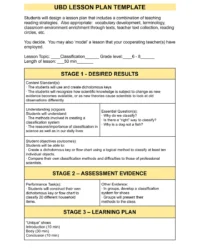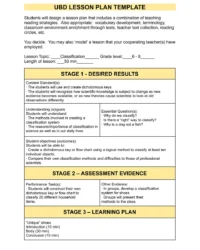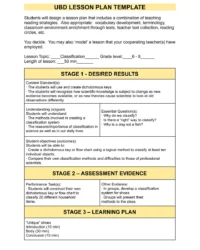Navigating the world of elementary education can feel like a grand adventure, both for teachers and their young learners. Every day brings new discoveries, challenges, and opportunities to shape curious minds. But how do you ensure that all these wonderful moments truly add up to deep, meaningful learning? That’s where a thoughtful planning approach, like Understanding by Design (UBD), comes into play. It’s a powerful framework that shifts our focus from merely “teaching content” to “ensuring understanding.” Imagine having a clear roadmap for every unit, ensuring every activity serves a purpose, leading students to genuine comprehension. This is the promise of using an elementary UBD lesson plan template, a tool that can transform your teaching practice.
For elementary school teachers, planning isn’t just about listing activities; it’s about orchestrating a symphony of learning experiences that are age-appropriate, engaging, and effective. Traditional lesson planning often starts with what we’ll do tomorrow, but UBD flips that on its head. It encourages us to begin with the end in mind: what do we want our students to truly understand, know, and be able to do by the end of a unit? This “backward design” approach helps create coherence and intentionality in your teaching, ensuring that every piece of the puzzle contributes to the bigger picture of student mastery. It empowers you to design learning journeys that stick, rather than just covering material that might quickly be forgotten.
Why Embrace UBD for Elementary Teaching?
Understanding by Design, often referred to as UBD, is more than just a planning methodology; it is a philosophy that champions deep understanding over superficial coverage. At its core, UBD asks educators to consider what enduring understandings students should achieve, what essential questions they should be able to answer, and what knowledge and skills they need to demonstrate. This backward approach contrasts with traditional planning, which often begins with content or activities. For elementary teachers, this means a shift from “What am I going to teach tomorrow?” to “What do I want my students to truly grasp by the end of this unit, and how will I know they’ve grasped it?”
The beauty of UBD for elementary education lies in its ability to bring clarity and purpose to every lesson. Young learners thrive on clear expectations and a sense of direction. When a teacher has a well-defined understanding of the desired outcomes, they can design activities that are not just fun, but also strategically aligned to those goals. This intentionality helps foster a more engaging and effective learning environment, where students are active participants in their own understanding, rather than passive recipients of information. It ensures that the learning journey is cohesive, building step-by-step towards significant insights.
Furthermore, UBD provides a robust framework for assessment. By first identifying what understanding looks like, teachers can then design authentic performance tasks that allow students to demonstrate their learning in meaningful ways. This moves beyond simple recall or multiple-choice questions, encouraging students to apply their knowledge and skills in real-world contexts. For elementary students, this might involve creating a presentation, solving a practical problem, or explaining a concept to a peer, all of which provide valuable insights into their level of comprehension.
Adopting UBD can also significantly streamline a teacher’s planning process. While it requires thoughtful consideration upfront, the clarity it provides ultimately saves time and reduces stress. Instead of constantly searching for new activities, teachers can design lessons that are tightly aligned with their desired results and assessment evidence. This creates a powerful synergy between curriculum, instruction, and assessment, ensuring that all three elements work in harmony to support student learning. It is about working smarter, not just harder, to achieve truly impactful educational outcomes for our youngest learners.
Stage 1: Identify Desired Results
This initial stage is the cornerstone of the UBD framework. It prompts you to think deeply about what you want your elementary students to know, understand, and be able to do at the end of a unit. This goes beyond just listing topics; it involves identifying enduring understandings (big ideas), essential questions that spark inquiry, and specific knowledge and skills students will acquire. For example, instead of just “learn about plants,” an enduring understanding might be “Living things have unique characteristics and needs that allow them to survive in diverse environments,” with an essential question like “How do plants adapt to their surroundings?” This clear focus sets the stage for all subsequent planning.
Stage 2: Determine Acceptable Evidence
Once you’ve identified your desired results, the next step is to consider how students will demonstrate that they have achieved those results. This stage is all about assessment. It involves designing authentic performance tasks that allow students to apply their understanding, as well as considering other forms of evidence like quizzes, observations, and dialogues. For elementary students, these tasks should be developmentally appropriate and engaging. For instance, if the desired result is understanding plant parts and functions, a performance task might involve students designing and labeling a model plant, explaining the role of each part, or even growing their own plant and documenting its changes.
Stage 3: Plan Learning Experiences and Instruction
With your desired results and assessment in mind, you can now plan the actual learning activities. This is where you design lessons, choose resources, and structure experiences that will help students achieve the identified understandings and prepare them for the performance tasks. This stage is dynamic and iterative, requiring you to think about how to engage students, differentiate instruction for diverse learners, and provide opportunities for practice and feedback. For an elementary unit on plants, activities could include reading non-fiction texts, observing live plants, conducting simple experiments, drawing diagrams, and participating in discussions, all carefully selected to build towards the big ideas identified in Stage 1.
Crafting Your Elementary UBD Lesson Plan Template
Creating or utilizing a robust elementary UBD lesson plan template is perhaps the most practical step you can take to implement this powerful framework. A well-designed template serves as a consistent guide, ensuring you hit all the critical components of backward design without missing a beat. It provides a structured space to articulate your goals, plan for evidence of learning, and then map out the engaging activities that will get your students there. Think of it as your personal blueprint for success, making the UBD process intuitive and efficient, even for busy elementary educators.
When you’re putting together your elementary UBD lesson plan template, consider what essential categories and prompts will genuinely help you think through the entire learning cycle. It should naturally guide you through the three stages of UBD, prompting thoughtful reflection at each step. This isn’t just about filling in blanks; it’s about prompting deeper pedagogical thought, encouraging you to connect the dots between what you teach, how you assess, and what students ultimately understand. A great template becomes a thinking partner, pushing you to clarify your intentions and methods.
Ultimately, a well-structured elementary UBD lesson plan template empowers you to create coherent, standards-aligned, and deeply engaging learning experiences for your students. It moves you beyond simply covering content to genuinely fostering understanding, ensuring that every minute of instructional time is purposeful and effective. It’s an invaluable asset for any elementary teacher committed to profound student learning.
Here are some key sections your elementary UBD lesson plan template should ideally include:
- Unit Title and Grade Level: Clear identification of the unit’s focus and target audience.
- Duration of Unit: Estimation of how long the unit will run.
- Desired Results (Stage 1):
- Established Goals/Standards: Specific content and skill standards addressed.
- Enduring Understandings: The big ideas students should grasp.
- Essential Questions: Open-ended, thought-provoking questions that guide inquiry.
- Knowledge: What students will know (facts, concepts).
- Skills: What students will be able to do (processes, abilities).
- Acceptable Evidence (Stage 2):
- Performance Tasks: Authentic assessment activities.
- Other Evidence: Quizzes, observations, discussions, homework.
- Learning Plan (Stage 3):
- Learning Activities: Detailed sequence of lessons, activities, and instructional strategies.
- WHERETO Elements: Guiding questions for planning (Where, Hook, Explore, Rethink, Exhibit, Tailor, Organize).
- Differentiation Strategies: Plans for supporting diverse learners.
- Resources: Materials, technology, and literature needed.
Adopting Understanding by Design, especially with the aid of a structured template, truly transforms elementary education. It shifts the paradigm from merely delivering curriculum to purposefully cultivating deep understanding and essential skills in our youngest learners. By beginning with the end in mind, teachers can design learning experiences that are not only rich and engaging but also strategically aligned to ensure students genuinely grasp the big ideas. This intentional approach minimizes guesswork and maximizes the impact of every lesson.
Ultimately, investing time in creating or adapting a comprehensive elementary UBD lesson plan template empowers educators to become master architects of learning. It ensures coherence across units, provides clear benchmarks for student success, and fosters an environment where curiosity thrives and understanding takes root. This systematic yet flexible framework is a powerful ally in nurturing the bright minds of tomorrow, setting them on a path for lifelong learning and discovery.


